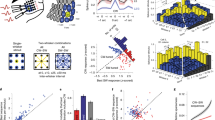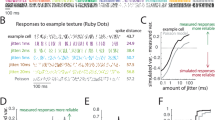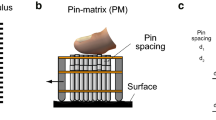Abstract
It is generally assumed that primary sensory neurons transmit information by their firing rates. However, during natural object manipulations, tactile information from the fingertips is used faster than can be readily explained by rate codes. Here we show that the relative timing of the first impulses elicited in individual units of ensembles of afferents reliably conveys information about the direction of fingertip force and the shape of the surface contacting the fingertip. The sequence in which different afferents initially discharge in response to mechanical fingertip events provides information about these events faster than the fastest possible rate code and fast enough to account for the use of tactile signals in natural manipulation.
This is a preview of subscription content, access via your institution
Access options
Subscribe to this journal
Receive 12 print issues and online access
$209.00 per year
only $17.42 per issue
Buy this article
- Purchase on Springer Link
- Instant access to full article PDF
Prices may be subject to local taxes which are calculated during checkout





Similar content being viewed by others
References
Adrian, E.D. The Basis of Sensation (W.W. Norton, New York, 1928).
Johansson, R.S. & Westling, G. Roles of glabrous skin receptors and sensorimotor memory in automatic control of precision grip when lifting rougher or more slippery objects. Exp. Brain Res. 56, 550–564 (1984).
Johansson, R.S. & Westling, G. Signals in tactile afferents from the fingers eliciting adaptive motor responses during precision grip. Exp. Brain Res. 66, 141–154 (1987).
Jenmalm, P. & Johansson, R.S. Visual and somatosensory information about object shape control manipulative finger tip forces. J. Neurosci. 17, 4486–4499 (1997).
Johansson, R.S., Häger, C. & Riso, R. Somatosensory control of precision grip during unpredictable pulling loads. II. Changes in load force rate. Exp. Brain Res. 89, 192–203 (1992).
Häger-Ross, C., Cole, K.J. & Johansson, R.S. Grip force responses to unanticipated object loading: Load direction reveals body- and gravity-referenced intrinsic task variables. Exp. Brain Res. 110, 142–150 (1996).
Macefield, V.G., Hager Ross, C. & Johansson, R.S. Control of grip force during restraint of an object held between finger and thumb: responses of cutaneous afferents from the digits. Exp. Brain Res. 108, 155–171 (1996).
Johansson, R.S., Lemon, R.N. & Westling, G. Time varying enhancement of human cortical excitability mediated by cutaneous inputs during precision grip. J. Physiol. (Lond.) 481, 761–775 (1994).
Rolls, E.T. & Tovee, M.J. Processing speed in the cerebral cortex and the neurophysiology of visual masking. Proc. R. Soc. Lond. B Biol. Sci. 257, 9–15 (1994).
Nielsen, J., Petersen, N. & Fedirchuk, B. Evidence suggesting a transcortical pathway from cutaneous foot afferents to tibialis anterior motoneurones in man. J. Physiol. (Lond.) 501, 473–484 (1997).
Westling, G. & Johansson, R.S. Responses in glabrous skin mechanoreceptors during precision grip in humans. Exp. Brain Res. 66, 128–140 (1987).
Thorpe, S., Delorme, A. & Van Rullen, R. Spike-based strategies for rapid processing. Neural Net. 14, 715–725 (2001).
Birznieks, I., Jenmalm, P., Goodwin, A. & Johansson, R. Encoding of direction of fingertip forces by human tactile afferents. J. Neurosci. 21, 8222–8237 (2001).
Jenmalm, P., Birznieks, I., Goodwin, A.W. & Johansson, R.S. Influence of object shape on responses of human tactile afferents under conditions characteristic of manipulation. Eur. J. Neurosci. 18, 164–176 (2003).
Vallbo, A.B. & Hagbarth, K.E. Activity from skin mechanoreceptors recorded percutaneously in awake human subjects. Exp. Neurol. 21, 270–289 (1968).
Johansson, R.S. & Vallbo, Å.B. Tactile sensory coding in the glabrous skin of the human hand. Trends Neurosci. 6, 27–31 (1983).
Johansson, R.S. Tactile sensibility in the human hand: receptive field characteristics of mechanoreceptive units in the glabrous skin area. J. Physiol. (Lond.) 281, 101–125 (1978).
Johansson, R.S. & Vallbo, A.B. Spatial properties of the population of mechanoreceptive units in the glabrous skin of the human hand. Brain Res. 184, 353–366 (1980).
Johansson, R.S. & Vallbo, A.B. Detection of tactile stimuli. Thresholds of afferent units related to psychophysical thresholds in the human hand. J. Physiol. (Lond.) 0297, 405–422 (1979).
Goodwin, A.W., Browning, A.S. & Wheat, H.E. Representation of curved surfaces in responses of mechanoreceptive afferent fibers innervating the monkey's fingerpad. J. Neurosci. 15, 798–810 (1995).
Maeno, T., Kobay-Ashi, K. & Yamazaki, N. Relationship between the structure of human finger tissue and the location of tactile receptors. JSME Int. J. 41, 94–100 (1998).
Pawluk, D.T. & Howe, R.D. Dynamic lumped element response of the human fingerpad. J. Biomech. Eng. 121, 178–183 (1999).
Nakazawa, N., Ikeura, R. & Inooka, H. Characteristics of human fingertips in the shearing direction. Biol. Cybern. 82, 207–214 (2000).
Johansson, R.S. & Vallbo, A.B. Tactile sensibility in the human hand: relative and absolute densities of four types of mechanoreceptive units in glabrous skin. J. Physiol. (Lond.) 286, 283–300 (1979).
Phillips, J.R., Johansson, R.S. & Johnson, K.O. Responses of human mechanoreceptive afferents to embossed dot arrays scanned across fingerpad skin. J. Neurosci. 12, 827–839 (1992).
Trulsson, M. & Essick, G.K. Low-threshold mechanoreceptive afferents in the human lingual nerve. J. Neurophysiol. 77, 737–748 (1997).
Kennedy, P.M. & Inglis, J.T. Distribution and behaviour of glabrous cutaneous receptors in the human foot sole. J. Physiol. (Lond.) 538, 995–1002 (2002).
Johansson, R.S. & Cole, K.J. Sensory-motor coordination during grasping and manipulative actions. Curr. Opin. Neurobiol. 2, 815–823 (1992).
Johansson, R.S. Sensory input and control of grip. in Sensory Guidance of Movement. Novartis Foundation Symposium 218. 45–59 (Wiley & Sons, Chichester, 1998).
Johansson, R.S., Landström, U. & Lundström, R. Responses of mechanoreceptive afferent units in the glabrous skin of the human hand to sinusoidal skin displacements. Brain Res. 244, 17–25 (1982).
Pubols, B.H. Jr. Factors affecting cutaneous mechanoreceptor response: II. Changes in mechanical properties of skin with repeated stimulation. J. Neurophysiol. 47, 530–542 (1982).
Panzeri, S., Petersen, R.S., Schultz, S.R., Lebedev, M. & Diamond, M.E. The role of spike timing in the coding of stimulus location in rat somatosensory cortex. Neuron 29, 769–777 (2001).
Petersen, R.S., Panzeri, S. & Diamond, M.E. Population coding of stimulus location in rat somatosensory cortex. Neuron 32, 503–514 (2001).
Rowe, M.J. Synaptic transmission between single tactile and kinaesthetic sensory nerve fibers and their central target neurones. Behav. Brain Res. 135, 197–212 (2002).
Usrey, W.M. The role of spike timing for thalamocortical processing. Curr. Opin. Neurobiol. 12, 411–417 (2002).
Meister, M. & Berry, M.J. The neural code of the retina. Neuron 22, 435–450 (1999).
Reich, D.S., Mechler, F. & Victor, J.D. Temporal coding of contrast in primary visual cortex: when, what and why. J. Neurophysiol. 85, 1039–1050 (2001).
Gerstner, W. & Kistler, W.M. Spiking Neuron Models (Cambridge Univ. Press, Cambridge, 2002).
Johansson, R.S., Westling, G., Bäckström, A. & Flanagan, J.R. Eye-hand coordination in object manipulation. J. Neurosci. 21, 6917–6932 (2001).
Sommer, M.A. & Wurtz, R.H. A pathway in primate brain for internal monitoring of movements. Science 296, 1480–1482 (2002).
Harris, F., Jabbur, S.J., Morse, R.W. & Tow, A.L. Influence of the cerebral cortex on the cuneate nucleus of the monkey. Nature 208, 1215–1216 (1965).
Adkins, R.J., Morse, R.W. & Towe, A.L. Control of somatosensory input by cerebral cortex. Science 153, 1020–1022 (1966).
Ergenzinger, E.R., Glasier, M.M., Hahm, J.O. & Pons, T.P. Cortically induced thalamic plasticity in the primate somatosensory system. Nat. Neurosci. 1, 226–229 (1998).
Engel, A.K., Fries, P. & Singer, W. Dynamic predictions: oscillations and synchrony in top-down processing. Nat. Rev. Neurosci. 2, 704–716 (2001).
Hopfield, J.J. Pattern recognition computation using action potential timing for stimulus representation. Nature 376, 33–36 (1995).
Carr, C.E. Processing of temporal information in the brain. Annu. Rev. Neurosci. 16, 223–243 (1993).
Kakuda, N. Conduction velocity of low-threshold mechanoreceptive afferent fibers in the glabrous and hairy skin of human hands measured with microneurography and spike-triggered averaging. Neurosci. Res. 15, 179–188 (1992).
Zar, J.H. Biostatistical Analysis (Prentice-Hall, Upper Saddle River, New Jersey, USA 1996).
Acknowledgements
We thank G. Westling, L. Bäckström and M. Andersson for technical support, and A. Goodwin and P. Jenmalm for their contributions during the experiments. This work was supported by the Swedish Medical Research Council (project 08667), J.C. Kempe's Memorial Foundation and the 5th Framework Program of the EU (project IST-2001-33073).
Author information
Authors and Affiliations
Corresponding author
Ethics declarations
Competing interests
The authors declare no competing financial interests.
Rights and permissions
About this article
Cite this article
Johansson, R., Birznieks, I. First spikes in ensembles of human tactile afferents code complex spatial fingertip events. Nat Neurosci 7, 170–177 (2004). https://doi.org/10.1038/nn1177
Received:
Accepted:
Published:
Issue Date:
DOI: https://doi.org/10.1038/nn1177
This article is cited by
-
Distinct sensorimotor mechanisms underlie the control of grasp and manipulation forces for dexterous manipulation
Scientific Reports (2023)
-
Robust encoding of natural stimuli by neuronal response sequences in monkey visual cortex
Nature Communications (2023)
-
Time-encoded multiplication-free spiking neural networks: application to data classification tasks
Neural Computing and Applications (2023)
-
Functional mimicry of Ruffini receptors with fibre Bragg gratings and deep neural networks enables a bio-inspired large-area tactile-sensitive skin
Nature Machine Intelligence (2022)
-
Efficient tactile encoding of object slippage
Scientific Reports (2022)



